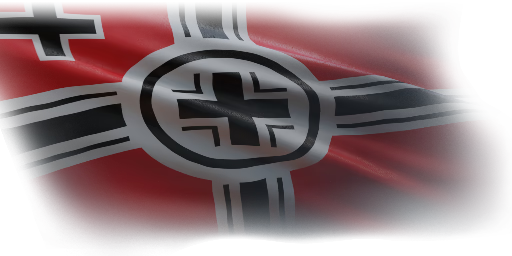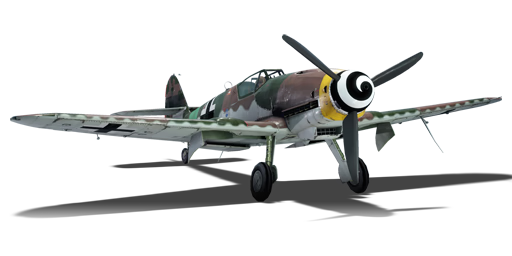



The Bf 109 K-4 is a German fighter. It has been in the game since the start of the Open Beta Test prior to Update 1.27. The Kurfürst is the pinnacle of the famed 109 series. "Kurfürst," representing the letter "K" in the Wehrmacht phonetic alphabet, translates to "prince-elector", a reference to the Electors of the Holy Roman Empire. The K-4's frame is the last iteration and was focused on ease of production rather than performance, yet it features the best power to weight ratio and acceleration of any 109, turning this machine into a beast. However, the age of the design is reflected in its poor high-speed characteristics.
Use the plane's outstanding climb rate and speed retention. Boom and zoom tactics should be this plane's primary mode of fighting. It has good acceleration when using WEP. This grants the machine reasonable diving and climbing abilities. If chased, dodge away from the enemy with fancy manoeuvres without losing too much speed. In Realistic Battles, try to do a climbing spiral, but be sure to be in a higher energy state than the enemy! A miscalculation and the foe will have the opportunity for an easy deflection shot.
However, there are also downsides. The top speed can be reached quickly, yet the plane is not fast when stock. While it does have an edge in agility, it has bad low-speed manoeuvrability. Furthermore, foes will not usually engage in manoeuvring combat, rendering any manoeuvrability advantage moot.
The K-4 can outmanoeuvre these planes at medium speeds (<450 km/h IAS): P-51 (all types), P-47D, Typhoons and the La-9. However, it will have a hard time dealing with other late Rank IV aircraft, especially Spitfires. It is highly recommended to use rudder during rolls, as this increases the roll rate dramatically. This is useful if when trying to force an overshoot or when avoiding shots.
flaps
flaps
flaps
brake
| Belt | Belt filling | Armor penetration (mm) at a distance: | |||||
|---|---|---|---|---|---|---|---|
| 10 m | 100 m | 500 m | 1000 m | 1500 m | 2000 m | ||
| HEI-T/I | 6 | 6 | 6 | 6 | 6 | 6 | |
| HEI-T/HEI-T/HEI-T/HEF-I | 4 | 4 | 4 | 4 | 4 | 4 | |
| HEI-T/HEI-T/HEI-T | 4 | 4 | 4 | 4 | 4 | 4 | |
| HEI | 4 | 4 | 4 | 4 | 4 | 4 | |
| Belt | Belt filling | Armor penetration (mm) at a distance: | |||||
|---|---|---|---|---|---|---|---|
| 10 m | 100 m | 500 m | 1000 m | 1500 m | 2000 m | ||
| IT/AP-T/IAI | 19 | 16 | 8 | 4 | 2 | 1 | |
| AP-T/AP-T/IT/IT/IAI | 19 | 16 | 8 | 4 | 2 | 1 | |
| AP-T | 19 | 16 | 8 | 4 | 2 | 1 | |
| IAI | 4 | 4 | 4 | 4 | 0 | 0 | |
| AP-I | 19 | 16 | 8 | 4 | 2 | 1 | |
| Belt | Belt filling | Armor penetration (mm) at a distance: | |||||
|---|---|---|---|---|---|---|---|
| 10 m | 100 m | 500 m | 1000 m | 1500 m | 2000 m | ||
| IT/IT/APHE/HEI | 21 | 19 | 8 | 3 | 1 | 1 | |
| IT/HEI/HEI/AP-I | 27 | 24 | 14 | 7 | 3 | 2 | |
| AP-I/HEI/HEI/HEI/HEI/IT | 27 | 24 | 14 | 7 | 3 | 2 | |
| APHE/APHE/APHE/IT | 21 | 19 | 8 | 3 | 1 | 1 | |
| FI-T/FI-T/FI-T/IT/IT | 21 | 19 | 8 | 3 | 1 | 1 | |
| HEI/HEI/HEI/APHE/AP-I | 27 | 24 | 14 | 7 | 3 | 2 | |
| Belt | Belt filling | Armor penetration (mm) at a distance: | |||||
|---|---|---|---|---|---|---|---|
| 10 m | 100 m | 500 m | 1000 m | 1500 m | 2000 m | ||
| IT/AP-T/IAI | 19 | 16 | 8 | 4 | 2 | 1 | |
| AP-T/AP-T/IT/IT/IAI | 19 | 16 | 8 | 4 | 2 | 1 | |
| AP-T | 19 | 16 | 8 | 4 | 2 | 1 | |
| IAI | 4 | 4 | 4 | 4 | 0 | 0 | |
| AP-I | 19 | 16 | 8 | 4 | 2 | 1 | |












Flight performance | |
|---|---|
Survivability |
|---|
Weaponry | ||
|---|---|---|